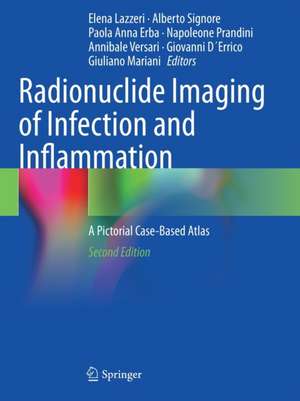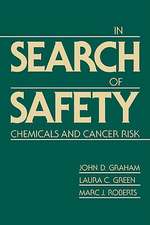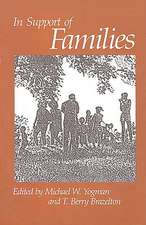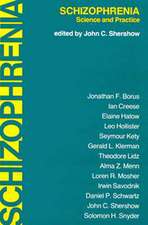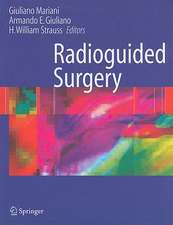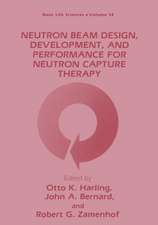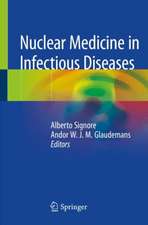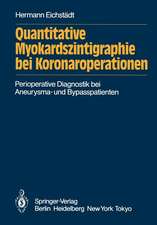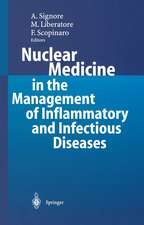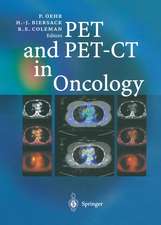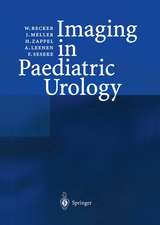Radionuclide Imaging of Infection and Inflammation: A Pictorial Case-Based Atlas
Editat de Elena Lazzeri, Alberto Signore, Paola Anna Erba, Napoleone Prandini, Annibale Versari, Giovanni D´Errico, Giuliano Marianien Limba Engleză Paperback – 23 ian 2022
Written by respected experts in the field, the book will be an invaluable tool for residents in nuclear medicine, as well as for other specialists.
| Toate formatele și edițiile | Preț | Express |
|---|---|---|
| Paperback (2) | 732.56 lei 6-8 săpt. | |
| Springer International Publishing – 23 ian 2022 | 732.56 lei 6-8 săpt. | |
| Springer – 23 aug 2016 | 1109.08 lei 6-8 săpt. | |
| Hardback (1) | 1056.38 lei 3-5 săpt. | |
| Springer International Publishing – 23 ian 2021 | 1056.38 lei 3-5 săpt. |
Preț: 732.56 lei
Preț vechi: 771.12 lei
-5% Nou
Puncte Express: 1099
Preț estimativ în valută:
140.18€ • 144.61$ • 116.98£
140.18€ • 144.61$ • 116.98£
Carte tipărită la comandă
Livrare economică 26 martie-09 aprilie
Preluare comenzi: 021 569.72.76
Specificații
ISBN-13: 9783030621773
ISBN-10: 3030621774
Pagini: 356
Ilustrații: XIV, 356 p. 303 illus., 213 illus. in color.
Dimensiuni: 210 x 279 mm
Greutate: 0.84 kg
Ediția:2nd ed. 2021
Editura: Springer International Publishing
Colecția Springer
Locul publicării:Cham, Switzerland
ISBN-10: 3030621774
Pagini: 356
Ilustrații: XIV, 356 p. 303 illus., 213 illus. in color.
Dimensiuni: 210 x 279 mm
Greutate: 0.84 kg
Ediția:2nd ed. 2021
Editura: Springer International Publishing
Colecția Springer
Locul publicării:Cham, Switzerland
Cuprins
1 Normal Findings from Different Radiopharmaceuticals and Techniques, with Variants and Pitfalls.- 2 Nuclear Medicine Imaging of Soft Tissue Infections.- 3 Nuclear Medicine Imaging of Bone and Joint Infection.- 4 Miscellaneous Bone and Joint conditions.- 5 Nuclear Medicine Imaging of Joint Prosthesis Infections.- 6 Nuclear Medicine Imaging of Vascular Prosthesis.- 7 Nonorthopedic or Cardiovascular Implantable Device Infection.- 8 Nuclear Medicine Imaging of Infections and Inflammation of Central Nervous System, Head and Neck Structures.- 9 Infective Endocarditis and Cardiovascular Implantable Electronic Device Infection.- 10 Nuclear Medicine Imaging of Fever of Unknown Origin.- 11 Nuclear Medicine Imaging of Abdominal Infections and Inflammation.- 12 Nuclear Medicine Imaging of Diabetic Foot.- 13 Nuclear Medicine Imaging of Lung Infection.- 14 Nuclear Medicine Imaging in Chronic Inflammatory Diseases.
Recenzii
“A major didactic value is in the representation, in each illustrated case … . The reader, both younger and the most experienced, has the opportunity to understand or refresh the pathophysiological bases … . this atlas allows an excellent training on the use of techniques and in the interpretation of images acquired with radionuclide procedures. It can result very useful not only to nuclear physicians and radiologists, but also to clinicians … .” (Milena Masone and Luigi Mansi, European Journal of Nuclear Medicine and Molecular Imaging, Vol. 48, 2021)
Notă biografică
Elena Lazzeri
Elena Lazzeri specialized in Nuclear Medicine at the University of Pisa (Italy) and did her PhD in 2009 at the University Medical Center Groningen, Groningen (The Netherlands).
Since 1995 she is Adjunct Professor for the Postgraduate Specialty in Nuclear Medicine at the University of Pisa, as well as lecturer at several teaching courses for Continuing Medical Education in Nuclear Medicine throughout Italy since 2002.
Among other activities, she is responsible for “Diagnosis of Infectious Diseases” at the Regional Center of Nuclear Medicine, University Hospital of Pisa, Pisa (Italy), Expert Consultant of the International Atomic Energy Agency (IAEA), Vienna (Austria), Teacher at the European School of Nuclear Medicine (ESNM) for Theoretical and Practical Courses on “Infection and Inflammation”, certified speaker of the European School of Multimodality Imaging and Therapy (ESMIT) and Senior Advisor of the EANM Committee on “Infection and Inflammation”.
Her main research interests are: Imaging infection and inflammation with particular emphasis to orthopedic infections, Fever of Unknown Origin, and cardiovascular infections with standard imaging techniques and with novel molecular imaging agents.
She is member of several national and international scientific societies, among them the European Association of Nuclear Medicine (EANM), the International Research Group in Immunoscintigraphy and Immuno-Therapy (IRIST) and the International Society of Radiolabelled Blood Elements (ISORBE).
Dr. Lazzeri has authored/co-authored over 40 articles in international peer-reviewed journals and over 15 invited chapters in books; she has also co-edited one book.
Alberto Signore
Prof. Alberto Signore is presently working at the Department of Medical-Surgical Sciences and of Translational Medicine of the University “Sapienza”, Rome, Italy, and he is Director of the Nuclear Medicine Unit, of Sant’Andrea Hospital, Rome. He is also full honorary professor of Nuclear Medicine at Department of Nuclear Medicine and Molecular Imaging, University Medical Center, Groningen, The Netherlands. After graduation in Medicine in 1984, he became specialist in Endocrinology (1987) and Nuclear Medicine (1991). He obtained a PhD in 2007 at the University of Groningen, the Netherlands. He is now also Consultant in Nuclear Medicine at Mayo Clinic, Rochester, USA; Treasurer of the International Research Group in Immunoscintigraphy and Therapy (IRIST); Chair of the “Inflammation/Infection” Committee of the European Association of Nuclear Medicine (EANM); Member of the Editorial Board of the Quarterly Journal of Nuclear Medicine and Molecular Imaging, Nuclear Medicine Communications, European Journal of Nuclear Medicine and Molecular Imaging, Nuclear Medicine Reviews, and other journals. He has been Visiting Professor in Nuclear Medicine, University of Ghent, Belgium; Consultant of the International Atomic Energy Agency (IAEA); Past-President of the International Society of Radiolabelled Blood Elements (ISORBE); Secretary and Past-President of the International Research Group in Immunoscintigraphy and Therapy (IRIST); Past-President of the international scientific association Nuclear Medicine Discovery (Nu.Me.D.). He authored more than 250 scientific publications in national and international journals), more than 30 book chapters and edited 5 books. Amongst the many awards and recognitions, it is worthwhile to mention the recent award for best Basic-Science publication in the Journal of Nuclear Medicine in 2015; the “Marie Curie” award of the European Association of Nuclear Medicine (EANM), in 2004, and the “Masahiro Iio” award of the World Federation of Nuclear Medicine and Biology (WFNMB), in 1994.
Paola A. Erba
Paola Anna Erba specialized in Nuclear Medicine at University of Pisa,Pisa (Italy) in 2002. Afterwards, she did a Master in Experimental Clinical Drugs Studies, University of Pisa, Pisa (Italy) and got the PhD at the University Medical Center Groningen, Groningen (The Netherlands).
Currently, she is Associate Professor of Nuclear Medicine at the University of Pisa Medical School, at the Department of Translational Research and Advanced Technologies in Medicine, Pisa (Italy). Her main research interests are: new markers of cancer and inflammation with particular focus on stromal antigens and the epithelial-mesenchymal transition, preclinical development and validation of new radiopharmaceuticals with both in vitro and in vivo testing, early in-human application for new radiolabelled molecules and for multimodality treatments, human application of immunoconjugates and radioimmunoconjugates for diagnosis and therapy, imaging infection and inflammation with particular emphasis to cardiovascular infections.
She is member ofseveral national and international scientific societies in the field of nuclear medicine and member of the editorial board or reviewer in international journals.
Prof. Erba has authored/co-authored over 90 articles in international peer-reviewed journals and 35 invited chapters in books; she has also co-edited 3 books.
Napoleone Prandini
Since 1985 to 2012 Dr Napoleone Prandini worked at the Regional Center of Nuclear Medicine of the University Hospital of Ferrara (Ferrara, Italy), where he implemented and developed the in vitro labelling of leukocytes, and also held teaching lectures at numerous courses and seminars at the national and international level. Since March 2012 he is Director of the Regional Center of Nuclear Medicine and PET of the University Hospital of Modena (Modena, Italy).
He is member of the Study Groups on Infections and Inflammations and of Radiometabolic Therapy of the Italian Association of Nuclear Medicine (AIMN), and has participated in the drafting of the AIMN guidelines on these topics. As AIMN Regional Delegate from 2002 to 2006, he has contributed to define the specific requirements for the Accreditation of Nuclear Medicine Structures of the Emilia Romagna Region, that have then be adopted also by other Italian regions.
He is also active as teacher at the Post-Graduate Specialty School in Nuclear Medicine of the University of Ferrara and as lecturer at the Post-Graduate Specialty School in Infectious and Tropical Diseases of the University of Verona and at the Course of Radiorheumatology organized by the Rheumatology Unit of the University of Genoa.
He is member of several international scientific societies.
He currently participates in numerous clinical trials based on scintigraphic, PET and therapeutic applications of radionuclides in lymphomas, breast cancer, amyloid research in the pre-clinical stages of dementia, and treatment of bone metastaseswith Radium-223.
Scientific production: over 200 articles in national and international journals.
Annibale Versari
Annibale Versari specialized in Nuclear Medicine at the University of Bologna. Since 2012, Dr. Versari is Director of the Nuclear Medicine Unit at the “S. Maria Nuova” Hospital (ASMN) in Reggio Emilia (Italy), and since 2015 also of the Oncology and High Technology Department.
His experience concerns all main issues of nuclear medicine: traditional diagnostic, PET/CT, nuclear therapy.
He worked also in the field of experimental research and chaired the Program for the development of “PET Applications in Radiation Therapy”, in collaboration with the Washington University of St Louis (Missouri) from 2002 to 2005.
From 2002 to 2006 he chaired the High Specialization Program for “PET and Cyclotron Activity”, ASMN, Reggio Emilia (Italy) and in 2006 the PET-Cyclotron Center, ASMN.
He is member of several national and international scientific associations such as the European Association of Nuclear Medicine (EANM) and the Society of Nuclear Medicine (SNM). He works as reviewer for different journals, among them The Journal of Nuclear Medicine, European Journal of Radiology, and the European Journal of Nuclear Medicine and Molecular Imaging.
Giovanni D’Errico
Since 2011 Dr. D’Errico is Chief of the Nuclear Medicine Unit of the “Pio XI Private Hospital” in Rome, after having previously taught at the Medical School of Catholic University “Sacro Cuore” in Rome (between 1977 and 2010).
After MD graduation at the University of Rome “La Sapienza” in 1972, he obtained the Post-Graduate Specialty in Internal Medicine at the same University (in 1977), then the Specialty in Nuclear Medicine at Catholic University “Sacro Cuore” in Rome (in 1980).
His main professional and scientific activities in the field of Nuclear Medicine concern the following topics: diagnostic imaging of infection/inflammation (mostly in orthopedics), radioguided surgery, diagnostic applications in general of conventional single-photon emission radionuclide imaging. For 7 years Dr. D’Errico has been Regional Delegate of the Italian Association of Nuclear Medicine (AIMN) for the Lazio Region. He has published over 170 articles in peer-reviewed international journals and several invited chapters in books. In addition, he has co-edited the books “Radionuclide Imaging of Infection and Inflammation – A Pictorial Case-Based Atlas” (published by Springer in 2013) and “Conventional Nuclear Medicine in Pediatrics – A Pictorial Case-Based Atlas” (published by Springer in 2017).
Giuliano Mariani
From 2001 to 2014, Dr. Giuliano Mariani was a Full Professor of Nuclear Medicine and Director of the Postgraduate Specialty School in Nuclear Medicine at the University of Pisa, as well as Director of the Regional Center of Nuclear Medicine at the University Hospital of Pisa (Pisa, Italy). He had previously held similar appointments at the University and the University Hospital of Genoa (Genoa, Italy), as Associate Professor of Nuclear Medicine. His academic career began at the CNR Institute of Clinical Physiology and at the University of Pisa in 1968. He was also a Visiting Scientist and Expert Consultant at the National Cancer Institute of the National Institutes of Health (NCI, NIH), Bethesda, Maryland, USA (between 1974–1978), and Visiting Professor and Lecturer of Radiology at the Harvard Medical School, Boston, Massachusetts, USA (between 1986–1990).
Dr. Mariani’s interests span virtually all of the clinical applications of Nuclear Medicine, including both diagnostic and therapeutic applications, with an emphasis on the development of novel techniques for radionuclide-based diagnosis and therapy of different tumors. He has published over 320 articles in international peer-reviewed journals. In addition to serving on the Editorial Boards of the most prestigious international journals on nuclear medicine and diagnostic imaging in general, Dr. Mariani has edited or co-edited 20 books and authored or coauthored over 100 book chapters. In addition, he currently serves as an Expert Consultant to the International Atomic Energy Agency (IAEA, Vienna) for developing and implementing nuclear medicine training programs around the world.
Elena Lazzeri specialized in Nuclear Medicine at the University of Pisa (Italy) and did her PhD in 2009 at the University Medical Center Groningen, Groningen (The Netherlands).
Since 1995 she is Adjunct Professor for the Postgraduate Specialty in Nuclear Medicine at the University of Pisa, as well as lecturer at several teaching courses for Continuing Medical Education in Nuclear Medicine throughout Italy since 2002.
Among other activities, she is responsible for “Diagnosis of Infectious Diseases” at the Regional Center of Nuclear Medicine, University Hospital of Pisa, Pisa (Italy), Expert Consultant of the International Atomic Energy Agency (IAEA), Vienna (Austria), Teacher at the European School of Nuclear Medicine (ESNM) for Theoretical and Practical Courses on “Infection and Inflammation”, certified speaker of the European School of Multimodality Imaging and Therapy (ESMIT) and Senior Advisor of the EANM Committee on “Infection and Inflammation”.
Her main research interests are: Imaging infection and inflammation with particular emphasis to orthopedic infections, Fever of Unknown Origin, and cardiovascular infections with standard imaging techniques and with novel molecular imaging agents.
She is member of several national and international scientific societies, among them the European Association of Nuclear Medicine (EANM), the International Research Group in Immunoscintigraphy and Immuno-Therapy (IRIST) and the International Society of Radiolabelled Blood Elements (ISORBE).
Dr. Lazzeri has authored/co-authored over 40 articles in international peer-reviewed journals and over 15 invited chapters in books; she has also co-edited one book.
Alberto Signore
Prof. Alberto Signore is presently working at the Department of Medical-Surgical Sciences and of Translational Medicine of the University “Sapienza”, Rome, Italy, and he is Director of the Nuclear Medicine Unit, of Sant’Andrea Hospital, Rome. He is also full honorary professor of Nuclear Medicine at Department of Nuclear Medicine and Molecular Imaging, University Medical Center, Groningen, The Netherlands. After graduation in Medicine in 1984, he became specialist in Endocrinology (1987) and Nuclear Medicine (1991). He obtained a PhD in 2007 at the University of Groningen, the Netherlands. He is now also Consultant in Nuclear Medicine at Mayo Clinic, Rochester, USA; Treasurer of the International Research Group in Immunoscintigraphy and Therapy (IRIST); Chair of the “Inflammation/Infection” Committee of the European Association of Nuclear Medicine (EANM); Member of the Editorial Board of the Quarterly Journal of Nuclear Medicine and Molecular Imaging, Nuclear Medicine Communications, European Journal of Nuclear Medicine and Molecular Imaging, Nuclear Medicine Reviews, and other journals. He has been Visiting Professor in Nuclear Medicine, University of Ghent, Belgium; Consultant of the International Atomic Energy Agency (IAEA); Past-President of the International Society of Radiolabelled Blood Elements (ISORBE); Secretary and Past-President of the International Research Group in Immunoscintigraphy and Therapy (IRIST); Past-President of the international scientific association Nuclear Medicine Discovery (Nu.Me.D.). He authored more than 250 scientific publications in national and international journals), more than 30 book chapters and edited 5 books. Amongst the many awards and recognitions, it is worthwhile to mention the recent award for best Basic-Science publication in the Journal of Nuclear Medicine in 2015; the “Marie Curie” award of the European Association of Nuclear Medicine (EANM), in 2004, and the “Masahiro Iio” award of the World Federation of Nuclear Medicine and Biology (WFNMB), in 1994.
Paola A. Erba
Paola Anna Erba specialized in Nuclear Medicine at University of Pisa,Pisa (Italy) in 2002. Afterwards, she did a Master in Experimental Clinical Drugs Studies, University of Pisa, Pisa (Italy) and got the PhD at the University Medical Center Groningen, Groningen (The Netherlands).
Currently, she is Associate Professor of Nuclear Medicine at the University of Pisa Medical School, at the Department of Translational Research and Advanced Technologies in Medicine, Pisa (Italy). Her main research interests are: new markers of cancer and inflammation with particular focus on stromal antigens and the epithelial-mesenchymal transition, preclinical development and validation of new radiopharmaceuticals with both in vitro and in vivo testing, early in-human application for new radiolabelled molecules and for multimodality treatments, human application of immunoconjugates and radioimmunoconjugates for diagnosis and therapy, imaging infection and inflammation with particular emphasis to cardiovascular infections.
She is member ofseveral national and international scientific societies in the field of nuclear medicine and member of the editorial board or reviewer in international journals.
Prof. Erba has authored/co-authored over 90 articles in international peer-reviewed journals and 35 invited chapters in books; she has also co-edited 3 books.
Napoleone Prandini
Since 1985 to 2012 Dr Napoleone Prandini worked at the Regional Center of Nuclear Medicine of the University Hospital of Ferrara (Ferrara, Italy), where he implemented and developed the in vitro labelling of leukocytes, and also held teaching lectures at numerous courses and seminars at the national and international level. Since March 2012 he is Director of the Regional Center of Nuclear Medicine and PET of the University Hospital of Modena (Modena, Italy).
He is member of the Study Groups on Infections and Inflammations and of Radiometabolic Therapy of the Italian Association of Nuclear Medicine (AIMN), and has participated in the drafting of the AIMN guidelines on these topics. As AIMN Regional Delegate from 2002 to 2006, he has contributed to define the specific requirements for the Accreditation of Nuclear Medicine Structures of the Emilia Romagna Region, that have then be adopted also by other Italian regions.
He is also active as teacher at the Post-Graduate Specialty School in Nuclear Medicine of the University of Ferrara and as lecturer at the Post-Graduate Specialty School in Infectious and Tropical Diseases of the University of Verona and at the Course of Radiorheumatology organized by the Rheumatology Unit of the University of Genoa.
He is member of several international scientific societies.
He currently participates in numerous clinical trials based on scintigraphic, PET and therapeutic applications of radionuclides in lymphomas, breast cancer, amyloid research in the pre-clinical stages of dementia, and treatment of bone metastaseswith Radium-223.
Scientific production: over 200 articles in national and international journals.
Annibale Versari
Annibale Versari specialized in Nuclear Medicine at the University of Bologna. Since 2012, Dr. Versari is Director of the Nuclear Medicine Unit at the “S. Maria Nuova” Hospital (ASMN) in Reggio Emilia (Italy), and since 2015 also of the Oncology and High Technology Department.
His experience concerns all main issues of nuclear medicine: traditional diagnostic, PET/CT, nuclear therapy.
He worked also in the field of experimental research and chaired the Program for the development of “PET Applications in Radiation Therapy”, in collaboration with the Washington University of St Louis (Missouri) from 2002 to 2005.
From 2002 to 2006 he chaired the High Specialization Program for “PET and Cyclotron Activity”, ASMN, Reggio Emilia (Italy) and in 2006 the PET-Cyclotron Center, ASMN.
He is member of several national and international scientific associations such as the European Association of Nuclear Medicine (EANM) and the Society of Nuclear Medicine (SNM). He works as reviewer for different journals, among them The Journal of Nuclear Medicine, European Journal of Radiology, and the European Journal of Nuclear Medicine and Molecular Imaging.
Giovanni D’Errico
Since 2011 Dr. D’Errico is Chief of the Nuclear Medicine Unit of the “Pio XI Private Hospital” in Rome, after having previously taught at the Medical School of Catholic University “Sacro Cuore” in Rome (between 1977 and 2010).
After MD graduation at the University of Rome “La Sapienza” in 1972, he obtained the Post-Graduate Specialty in Internal Medicine at the same University (in 1977), then the Specialty in Nuclear Medicine at Catholic University “Sacro Cuore” in Rome (in 1980).
His main professional and scientific activities in the field of Nuclear Medicine concern the following topics: diagnostic imaging of infection/inflammation (mostly in orthopedics), radioguided surgery, diagnostic applications in general of conventional single-photon emission radionuclide imaging. For 7 years Dr. D’Errico has been Regional Delegate of the Italian Association of Nuclear Medicine (AIMN) for the Lazio Region. He has published over 170 articles in peer-reviewed international journals and several invited chapters in books. In addition, he has co-edited the books “Radionuclide Imaging of Infection and Inflammation – A Pictorial Case-Based Atlas” (published by Springer in 2013) and “Conventional Nuclear Medicine in Pediatrics – A Pictorial Case-Based Atlas” (published by Springer in 2017).
Giuliano Mariani
From 2001 to 2014, Dr. Giuliano Mariani was a Full Professor of Nuclear Medicine and Director of the Postgraduate Specialty School in Nuclear Medicine at the University of Pisa, as well as Director of the Regional Center of Nuclear Medicine at the University Hospital of Pisa (Pisa, Italy). He had previously held similar appointments at the University and the University Hospital of Genoa (Genoa, Italy), as Associate Professor of Nuclear Medicine. His academic career began at the CNR Institute of Clinical Physiology and at the University of Pisa in 1968. He was also a Visiting Scientist and Expert Consultant at the National Cancer Institute of the National Institutes of Health (NCI, NIH), Bethesda, Maryland, USA (between 1974–1978), and Visiting Professor and Lecturer of Radiology at the Harvard Medical School, Boston, Massachusetts, USA (between 1986–1990).
Dr. Mariani’s interests span virtually all of the clinical applications of Nuclear Medicine, including both diagnostic and therapeutic applications, with an emphasis on the development of novel techniques for radionuclide-based diagnosis and therapy of different tumors. He has published over 320 articles in international peer-reviewed journals. In addition to serving on the Editorial Boards of the most prestigious international journals on nuclear medicine and diagnostic imaging in general, Dr. Mariani has edited or co-edited 20 books and authored or coauthored over 100 book chapters. In addition, he currently serves as an Expert Consultant to the International Atomic Energy Agency (IAEA, Vienna) for developing and implementing nuclear medicine training programs around the world.
Textul de pe ultima copertă
This atlas explores the latest advances in radionuclide imaging in the field of inflammatory diseases and infections, which now typically includes multimodality fusion imaging (e.g. in SPECT/CT and in PET/CT). In addition to describing the pathophysiologic and molecular mechanisms on which the radionuclide imaging of infection/inflammation is based, the clinical relevance and impact of such procedures are demonstrated in a collection of richly illustrated teaching cases, which describe the most commonly observed scintigraphic patterns, as well as anatomic variants and technical pitfalls. Special emphasis is placed on using tomographic multimodality imaging to increase both the sensitivity and specificity of radionuclide imaging.
The aim of the second edition of this book is to update the first (published in 2013) by reflecting the changes in this rapidly evolving field. Particular attention is paid to the latest advances in the radionuclide imaging of infection and inflammation, including the expanding role of hybrid imaging with [18F]FDG PET/CT SPECT/CT, without neglecting new radiotracers proposed for the imaging of infection/inflammation.
Written by respected experts in the field, the book will be an invaluable tool for residents in nuclear medicine, as well as for other specialists.
The aim of the second edition of this book is to update the first (published in 2013) by reflecting the changes in this rapidly evolving field. Particular attention is paid to the latest advances in the radionuclide imaging of infection and inflammation, including the expanding role of hybrid imaging with [18F]FDG PET/CT SPECT/CT, without neglecting new radiotracers proposed for the imaging of infection/inflammation.
Written by respected experts in the field, the book will be an invaluable tool for residents in nuclear medicine, as well as for other specialists.
Caracteristici
The format helps readers solve diagnostic cases encountered in everyday nuclear medicine practice Presents pearls and pitfalls, as well as useful take-home tips Written by respected experts in the field
